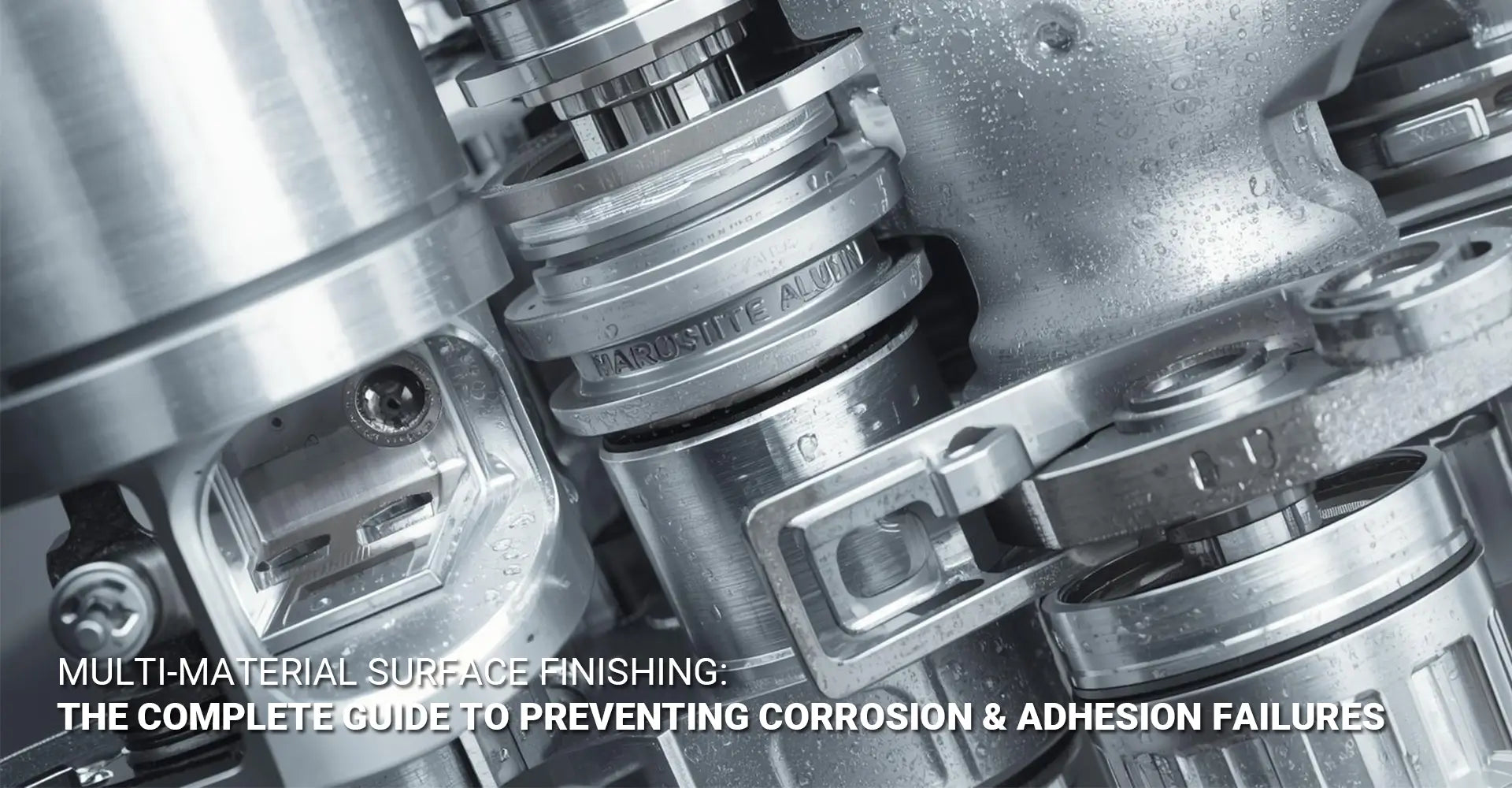How Do You Prevent Corrosion and Adhesion Failures in Multi-Material Assemblies?

How Do You Prevent Corrosion and Adhesion Failures in Multi-Material Assemblies?

When you combine aluminum, stainless steel, and plastics in a single product, you face a critical challenge. Therefore, choosing the right finishing strategy becomes more than just aesthetics. In fact, the wrong combination can lead to premature failures, costly recalls, and unhappy customers.
Quick Answer: Preventing Multi-Material Assembly Failures
Key Protection Methods:
- Use isolation barriers (nylon washers/sleeves) between dissimilar metals
- Apply unified coating systems like powder coating or PVD that work across all materials
- Avoid mixing anodizing with bare stainless steel components
- Test adhesion and corrosion resistance before full production runs
- Consider electrochemical compatibility during material selection phase
Multi-material assembly surface finishing requires careful planning and validation. However, with the right approach, you can achieve both durability and aesthetic appeal across different substrates.
Many manufacturers discover these challenges too late in the production cycle. As a result, understanding the fundamentals of galvanic corrosion and coating compatibility saves both time and money. Moreover, implementing proper testing protocols ensures your assemblies perform as expected in real-world conditions.
Table of Contents
- What Causes Galvanic Corrosion Between Aluminum and Stainless Steel?
- Which Surface Finishes Work Across Aluminum, Stainless Steel, and Plastics?
- How Do You Test Coating Adhesion on Multi-Material Assemblies?
- What Are the Most Common Multi-Material Finishing Mistakes?
- Conclusion
What Causes Galvanic Corrosion Between Aluminum and Stainless Steel?
Galvanic corrosion occurs when two dissimilar metals come into electrical contact in the presence of an electrolyte. Consequently, this creates an electrochemical reaction that accelerates corrosion on the more active metal. In other words, your assembly becomes an unintentional battery.
The Three Critical Factors
When you pair aluminum with stainless steel, three conditions must exist for galvanic corrosion:
- Different electrochemical potentials between the metals
- Direct electrical contact between the materials
- Presence of an electrolyte (moisture, salt, or conductive fluids)
Why Aluminum Always Loses
Aluminum sits much lower on the galvanic series compared to stainless steel. Therefore, aluminum becomes the anode (sacrificial metal) while stainless steel acts as the cathode (protected metal). Furthermore, anodizing actually worsens this problem because it makes the aluminum oxide layer more noble, increasing the potential difference with any exposed base aluminum.
Additionally, moisture and salts create the perfect electrolyte for this reaction. Even humidity in the air can provide enough electrolyte for corrosion to begin. As a result, outdoor applications face particularly high risk, especially in coastal or industrial environments where salt or pollutants are present.
The damage typically appears as white, powdery corrosion on aluminum surfaces. Meanwhile, the stainless steel remains perfectly intact because it receives cathodic protection from the sacrificial aluminum. Subsequently, this leads to loosened fasteners, weakened joints, and eventual structural failure of the assembly.
When working with CNC machining services, you must account for these electrochemical interactions from the design phase. Otherwise, even precision-machined components will fail prematurely when improperly finished and assembled.
Which Surface Finishes Work Across Aluminum, Stainless Steel, and Plastics?
Finding a compatible coating for dissimilar metals requires understanding each material's surface chemistry and adhesion requirements. Fortunately, several finishing technologies provide excellent multi-material finishing compatibility when properly applied.
Universal Finishing Systems
The following finishes offer the best compatibility across mixed material assemblies:
- Powder coating with proper primers
- PVD (Physical Vapor Deposition) coatings
- Electroless nickel plating
- Conversion coatings (chromate or phosphate treatments)
Detailed Finish Breakdown
Powder Coating provides the most practical solution for most applications. Indeed, modern powder formulations bond well to aluminum, stainless steel, and properly prepared plastics. Moreover, powder coating creates a thick barrier layer that prevents electrical contact between dissimilar metals. However, surface preparation remains critical for each material type.
PVD Coatings deliver superior hardness and wear resistance across multiple substrates. Nevertheless, they require specialized equipment and careful control of deposition parameters. Additionally, PVD works best when all surfaces undergo similar preparation protocols, which ensures uniform coating adhesion.
Electroless Nickel offers consistent coverage without requiring electrical current flow. Consequently, this eliminates concerns about preferential deposition on conductive surfaces. Furthermore, electroless nickel provides excellent corrosion resistance and serves as an ideal base for additional finishing layers.
Conversion Coatings chemically alter the metal surface to improve paint adhesion and provide corrosion resistance. Therefore, they work exceptionally well as pretreatment layers before applying top coats. However, different conversion chemistries work better on specific metals, so you may need multiple pretreatment steps.
For die casting components that combine with other materials, selecting the right galvanic corrosion prevention coating from the start prevents costly rework later. Similarly, understanding how each finish interacts with your assembly's unique material combination ensures long-term performance.
The key lies in viewing your assembly as a system rather than individual components. Thus, choosing a finish that performs adequately across all materials often beats selecting the absolute best finish for each material separately. After all, a unified coating strategy eliminates interface problems between differently finished components.
How Do You Test Coating Adhesion on Multi-Material Assemblies?
Testing proves whether your finishing process actually works before you commit to full production. Subsequently, implementing a comprehensive validation protocol catches problems early when they cost less to fix.
Four Essential Test Methods
Your validation program should include these critical assessments:
- Cross-cut tape test (ASTM D3359) for adhesion strength
- Salt spray testing (ASTM B117) for corrosion protection
- Thermal cycling for expansion compatibility
- Humidity testing for moisture resistance

Complete Testing Protocol
Cross-Cut Tape Test provides quick, reliable adhesion assessment for painted or powder-coated surfaces. First, you create a grid pattern of cuts through the coating down to the substrate. Next, you apply pressure-sensitive tape and remove it quickly. Finally, you evaluate how much coating came off according to standardized rating scales. Importantly, you should perform this test on each different material in your assembly because adhesion varies significantly between substrates.
Salt Spray Testing exposes your finished assembly to corrosive conditions that simulate years of environmental exposure. Specifically, a 5% salt solution sprays continuously onto test samples in a controlled chamber. Meanwhile, you inspect samples at regular intervals for signs of coating failure, undercutting, or corrosion at material interfaces. Generally, 500-1000 hours provides good confidence for most applications, though harsher environments may require extended testing.
Thermal Cycling reveals problems caused by different expansion rates between materials. During this test, samples move repeatedly between hot and cold temperatures while coated. Because aluminum expands faster than stainless steel, coatings must accommodate this differential movement. Otherwise, cracks develop at interfaces between materials, creating pathways for moisture and corrosion.
Humidity Testing identifies adhesion problems that only appear in moist conditions. In particular, some coatings lose adhesion when water molecules penetrate to the substrate interface. Furthermore, humidity testing often catches problems that salt spray misses because the failure mechanisms differ. Therefore, both tests complement each other in a complete validation program.
When evaluating surface finish options for production, these tests provide objective data rather than relying on assumptions. Moreover, testing with actual production materials and processes ensures results accurately predict real-world performance.
What Are the Most Common Multi-Material Finishing Mistakes?
Understanding common failures helps you avoid expensive mistakes during product development. Meanwhile, learning from others' problems proves far cheaper than discovering them yourself during production.
Top Five Finishing Errors
Manufacturers frequently make these preventable mistakes:
- Choosing finishes in isolation without considering material interactions
- Ignoring the galvanic series when selecting metal combinations
- Inadequate isolation between dissimilar metals
- Skipping compatibility testing to save time or money
- Neglecting design considerations like drainage and crevice geometry

Real-World Failure Examples
Mistake #1: Isolated Finish Selection remains the most common and costly error. For instance, a manufacturer might anodize aluminum housings, passivate stainless steel fasteners, and leave plastic components uncoated. While each finish provides excellent protection individually, together they create multiple galvanic couples and adhesion mismatches. Instead, selecting an anodizing painting plating combination that works across all materials prevents these interface problems.
Mistake #2: Ignoring Electrochemical Compatibility leads to rapid galvanic corrosion. Consider a product where designers specified aluminum fasteners with stainless steel parts simply because "both are corrosion-resistant metals." However, the 0.7-volt potential difference between these materials drives aggressive corrosion when moisture is present. Subsequently, fasteners corrode through within months instead of lasting years as expected.
Mistake #3: Poor Isolation Design allows electrical contact between dissimilar metals despite good intentions. Even tiny gaps in isolation barriers permit electrolyte access to metal-to-metal contact points. Furthermore, vibration can wear through protective coatings at contact areas, exposing bare metal. Therefore, robust isolation requires both physical barriers and adequate coating thickness at all potential contact zones.
Mistake #4: Inadequate Testing results from underestimating the complexity of surface finish for aluminum stainless steel assembly applications. Some manufacturers perform basic adhesion tests but skip corrosion testing or vice versa. However, coatings can pass adhesion tests while still allowing galvanic corrosion at material interfaces. Consequently, comprehensive testing across all failure modes becomes necessary for reliable predictions.
Mistake #5: Design Oversights create corrosion traps regardless of finishing quality. Specifically, horizontal surfaces that collect water, crevices that trap moisture, and designs that prevent complete coating coverage all promote corrosion. Additionally, sharp edges and corners receive thinner coating coverage, creating weak points in corrosion protection. Thus, designing for finishability proves just as important as selecting appropriate finishes.
When working with CNC metals and plastics in assemblies, recognizing these pitfalls early prevents redesigns and production delays. Similarly, consulting finishing experts during the design phase rather than after tooling commitment saves significant time and expense.
Applications in industrial machinery often involve harsh environments where these mistakes lead to safety issues beyond just cosmetic problems. Therefore, getting multi-material finishing right from the start becomes critical for both performance and liability reasons.
The solution requires an electrochemical compatibility coating strategy that considers your entire assembly as an integrated system. Furthermore, this systematic approach ensures all materials receive compatible surface treatments that prevent both galvanic corrosion and adhesion failures.
Conclusion
Successfully finishing multi-material assemblies demands more than applying good coatings to each component separately. Instead, you must think systematically about how different materials and finishes interact as a complete system. Moreover, this integrated approach prevents the galvanic corrosion and adhesion failures that plague assemblies designed with isolated component thinking.
Key Takeaways for Success:
First, always consider electrochemical compatibility when selecting materials and finishes for assemblies. Second, implement physical isolation barriers between dissimilar metals as your primary defense against galvanic corrosion. Third, choose unified coating systems that work adequately across all materials rather than optimal finishes for individual components. Fourth, validate your finishing approach through comprehensive testing before committing to production tooling.
Furthermore, remember that proper design details like drainage paths, crevice elimination, and adequate coating access often matter as much as coating selection itself. Therefore, involve finishing experts early in your design process rather than treating surface finishing as an afterthought.
By implementing these strategies, you create assemblies that maintain both appearance and structural integrity throughout their service life. Consequently, your products avoid premature failures while delivering the reliability your customers expect.
Recommended Resources
[Multi-material assembly surface finishing][^1]
[Galvanic corrosion prevention coating][^2]
[Surface finish for aluminum stainless steel assembly][^3]
[Compatible coating for dissimilar metals][^4]
[Multi-material finishing compatibility][^5]
[Anodizing painting plating combination][^6]
---
[^1]: Explore this link to discover advanced techniques and best practices for achieving high-quality surface finishes in multi-material assemblies.
[^2]: Learn about the science behind galvanic corrosion prevention coatings and their importance in extending the lifespan of metal components.
[^3]: Understanding the optimal surface finish can enhance durability and performance in metal assemblies.
[^4]: Exploring compatible coatings can prevent corrosion and ensure longevity in mixed metal applications.
[^5]: Understanding this concept is crucial for optimizing manufacturing processes and ensuring product durability.
[^6]: Exploring this combination can enhance your knowledge of surface treatments and improve product performance.





